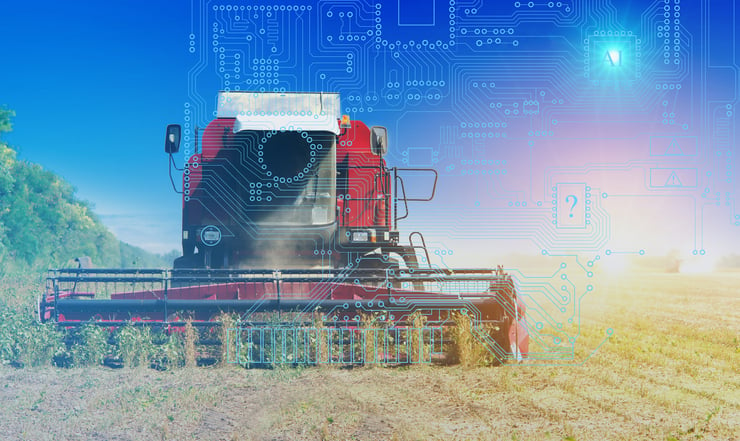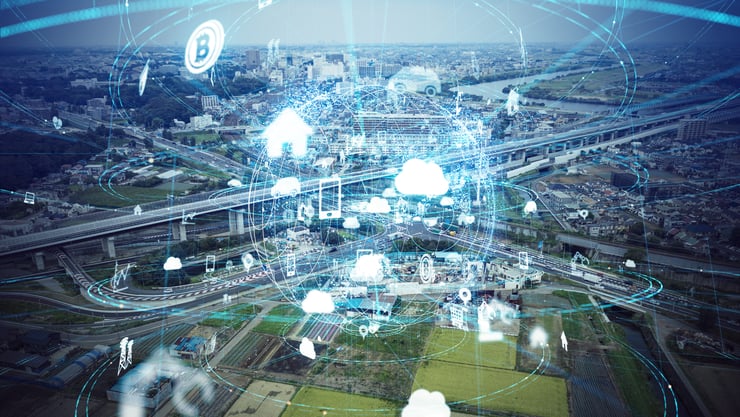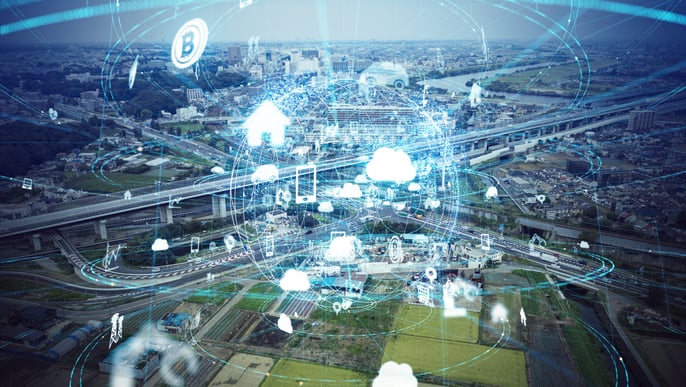Technologies in Agriculture
If you’re in the agricultural field, there’s no doubt that you’ve begun seeing a change in the industry. All over the United States, there has been a large push for farmers to incorporate technology into their craft. Every day more farms adopt emerging technologies in order to maximize product yields. For those who may be skeptical, we assure you that digital agriculture is the way of the future. This rise in technology not only lends itself to heightened productivity but also to a more manageable life for the farmers that adopt them.
For our partners in the dairy industry, new technologies have massive effects on how to raise and manage cattle. And they can make a world of difference in managing livestock and providing the market with the best dairy products imaginable. In the future, agriculture will continue to provide dairy farmers with new technologies capable of radically impacting the way they do business.
Digital Agriculture Emergence
These technologies have given way to a new term: digital agriculture. Digital agriculture is the integration of technology with current agricultural practices. Crop and livestock management become more productive as a result of cost-savings, data-gathering, and risk control. These technologies in agriculture are shaping the future for farmers, and ag-tech companies are leading the charge to maximize efficiency for America's fields and farmers.
Purdue’s agricultural department recently posted an article about digital agriculture. I took a lot from this article, and thought you might, too. I’ll break down a few of its sections below. At a glance, the newest technologies in agriculture have nothing to do with conventional equipment; instead, they are a product of the digital revolution. Data, artificial intelligence, and autonomous technology are shaping the future for those who work with crops and livestock.
Data Analysis in Ag
This change presents an interesting future for the agriculture industry. This prospect is one where workers can measure quantitative data, interpret that data, and use complex technology to maximize the yield of their goods and services. The future of agriculture is looming, and on the horizon rests a technological revolution for the world's workers.

Where did it all come from? The researchers at Purdue contend that the newest technologies in agriculture are a result of our previous scientific advances. The prevalence of new technology has increased so much; it was only a matter of time before it started to bleed over into other fields like agriculture. Automation and technological innovation are also the results of the nature of agriculture. Mechanization usually targets jobs that are very labor-intensive and time-consuming, and what field of work could be more labor and time-intensive than agriculture?
These are only a few examples of the many ways researchers employ digital agriculture technologies at Purdue. It is, in part, the ubiquity of advanced technologies and internet-capable devices that precipitated the surge in digital agriculture research and usage.
--Source
Emerging Technologies in Agriculture
The newest technologies in agriculture are ones that have been developed in other industries and applied to agricultural practices. These technologies come from fields like social science, economics, and technological development. Whether you’re a hog farmer in Arkansas or a dairy farmer in the Midwest, you’ll likely see some new technologies emerging on farms around you.
Technologies in agriculture take tried and trusted methods from other fields and apply them to agriculture. The future of agriculture looks bright with these changes and farmers should be ready to incorporate them into their practices.
Commonly used technologies include sensors, communication networks, unmanned aerial vehicles (UAVs), robotic machinery, Artificial Intelligence, and other advanced machinery and technologies. These tools are already utilized by researchers and Extension experts across campus and the state.
--Source
The researchers at Purdue are revolutionizing future agriculture. They currently teach farmers how to use technology like drones, sensors, and artificial intelligence. But they are also pioneering the industry with their Controlled Environmental Phenotyping Facility which observes how plants respond to weather patterns with digital imaging, and Purdue has also developed software that is being used to image live chickens, track their movement with accelerometers, and monitor their behavior with video feeds.
There’s no substitute for the agricultural industry. It keeps us fed and employs millions of people across the globe. We’ve improved upon ancient methods with machinery, but we’ve yet to fully incorporate cutting-edge technology into our practices. Purdue believes that these technologies can make the lives of these workers easier and more manageable.
There are too many new technologies in agriculture to name in this singular article. To do so would require an entire book. But we’ll break down the newest technologies in agriculture that caught our eye and are looking forward to seeing on our clients’ farms.
Sensors & Sleeping Cattle
Sensors may sound like a vague word for agriculture technology examples, but it’s because they are becoming one of the most versatile tools for people who work with plants and animals. Researchers at Purdue are currently using sensors to observe the circadian rhythm in cows.
These sensors can also be applied to multiple issues that agriculturalists face. Weather sensors can be installed to notify you of weather patterns capable of affecting your crops. They can notify you of impending natural disasters, or simply alert you that the plants need more water due to current weather conditions. Sensors can also tell you the proper time to harvest.
For livestock, sensors have much more information to give. Sensors can tell you when the optimal circumstances are for mating animals. They can give you insight into how your livestock is digesting their food. Sensors can also tell you if your livestock is properly growing or experiencing health issues.

All of the data imaginable is at a farmer’s fingertips with the use of sensors. How a sensor is useful to you is left only to your imagination. If a scientific process is taking place with your crops or livestock, the chances are that you can build a sensor to gain insight into what affects that process. According to Purdue’s findings, farms across the country that deal with livestock are currently taking advantage to maximize production.
Already, dairy farmers around the state and the country incorporate digital agriculture into management practices. Feed management software, dairy records software, milk meters, pedometers, and rumination collars (used to monitor cud-chewing) are common on dairy farms.
--Source
The dairy farms utilizing these sensors have made amazing discoveries about how early-life health influences milk consumption in auto-feeders. Using this information, researchers may have found an optimal amount of milk to optimize the health and efficiency of the cow and save the dairy farmer cost.
Smart Tech
Sensors are being used in many situations, but the previous example is a prime display of sensors’ usefulness. Using sensors in the future of agriculture doesn’t just maximize your output as a farm, it also saves you money simultaneously.
“The advent of smartphones and iPads has changed the landscape entirely with the capability now to make real-time decisions and to use new sensors that give instantaneous information,” Plaut continued. “We can now get data from many more sources than ever before and we can put those data together to make decisions. That is the power of digital agriculture.”
--Source
As animals stray from the herd, it can be tough to track them, but sensors allow you to easily find animals that may have gone astray. Likewise, we are excited by the prospect of geofencing your land, so that you can be notified whenever an animal leaves the boundaries of the farm.
Purdue is very proud of its new sensor system that monitors the health of their chickens, and the same types of sensors can be applied to other animals. It can sense when a disease outbreak has occurred or when the animals are showing signs of illness. Imagine being able to sense when your animals are getting sick and making adjustments so that they can recover faster.
Marisa Erasmus, assistant professor of animal sciences, explained that in addition to enhancing livestock’s productivity, digital agriculture can promote animal welfare and health. And, as it turns out, healthy animals are typically more productive.
--Source
Practical Farmstead Use
This methodology could be applied to multiple farms containing all types of animals. Horses, cows, chickens, and pigs are all viable candidates (just to name a few). Don’t be surprised to find these systems implemented within the next few years at multiple farms across the United States. For our partners in the dairy industry, this new technology means having healthy cows that carry a maximum level of productivity. Who doesn’t love that?
“We want our findings to be practical for farmers,” Erasmus said. “If we can use sensors to get information about when bird behavior changes due to a stressor, then we can identify early time points when intervention might happen.” Intervention will look different depending on the stressor but, for example, sensors can help indicate early signs of illness or heat stress, signaling that farmers may need to change the animals’ environment.
--Source
“Monitoring automatically and in real-time also has other benefits,” Erasmus continued. “We are able to collect more data, of course, but we can also help eliminate risk. If there is a disease outbreak, for example, you want to limit contact with animals early on to prevent spreading the disease. Different technologies can help do this.”
--Source
Autonomous Vehicles
Think about how many vehicles the average agriculturalist needs. Farmers need plows, tractors, and trucks just to name a few. It might take a few pairs of hands to utilize every vehicle at once, and if your farm rests on a large piece of farmland then you may need a couple of vehicles to maximize your productivity.

Agriculture in the future will utilize autonomous vehicles to make surveying and harvesting easier. The prime example of this new trend in digital agriculture is the use of UAVs (unmanned aerial vehicles). These vehicles take to the skies and highlight the benefits when farmers employ the use of technology in agriculture.
UAVs can be utilized to survey fields and check up on crop health. But the beauty behind autonomous vehicles is that it might begin to extend to other areas of farm life. If you could outfit your tractors, plows, and harvesters with artificial intelligence, then you could have a farm that’s run completely from a computer or tablet. These autonomous vehicles would allow you to be productive for more time in the day and cover more ground than usual for the average worker.
Agriculture technology examples usually fit under the umbrella of making products smarter, and this is no exception. Cars on the highway are already going through this change. Drivers are expected in the near future to be operating autonomous vehicles, there’s no reason that this technology can’t be applied to the world of digital agriculture.
These vehicles are already being produced in many countries like the United States, Japan, and Brazil. Agriculture in the future will be dominated by these devices. Automation is already being applied to farming and livestock, but the majority of automated devices are stationary. With the latest innovations in agriculture, there’s no reason that moving devices can’t be outfitted with data-driven technology that allows workers to focus on other tasks.
Dairy farmers would love to be able to reduce the amount of time spent feeding and caring for their animals, as long as it is still done correctly. The reality of digital agriculture is that machines can be used to do those things for you. Any data or observations that are collected about these animals can be stored and analyzed later in order to make adjustments to the cows feeding patterns, medicine needs, or overall care. But digital agriculture doesn’t just make you able to do more, it allows you to see more as well.
There’s often a disconnect with tech. You can get more done, but how often do you see and understand the processes behind your farm? Imagine being able to see more with digital agriculture. It’s possible with unmanned aerial vehicles.
UAVs can be used to survey large swaths of land in a short amount of time. These vehicles can also be used to gain insight into the movements of herd animals. If any animal separates from the herd, a UAV makes for a much better response time than conventional methods.
Transportation made Smarter
Transporting animals is often a hassle. One prospect of future agriculture is closer than you might think. Autonomous cars are quickly becoming a guarantee. This guarantee may not happen for the next couple of years. After all, the technology has a set time it must endure before being readily adopted. But many believe it is an innovation we'll see within this decade.
Transporting animals would be a small task with automatic transport. You’d simply load up the livestock to be transported, punch in the route, and watch as the transport drove away to its destination. Autonomous transport is one of the technologies in agriculture that looks like it’s on the horizon. Many of the technologies Purdue mentions are already being used, but are not widely adopted. This technological advance, however, seems to be the next leap in making the lives of farmers easier.
Many, Many More
The future of agriculture isn’t just reserved for these technologies; instead, the future may contain multiple technologies of different types. Farmers will utilize communication networks to monitor input from workers and communicate orders. Detailed imaging can be used to observe biological changes and non-discovered processes in livestock. Many companies are already experimenting with gene manipulation, and it’s not long before it rests in the hands of the average consumer.
It won’t be long before you drive across a field and see unmanned combines and workers on the ground carrying tablets. Digital agriculture is just beginning to take form and in the next few decades, artificial intelligence might be managing the farms altogether to maximize yield without excess waste. Things like soil exhaustion and pollution may be a thing of the past with a computer at the helm of farming.
These changes would allow farmers to shift their focus and widen their reach as a farm. You may see farm to table become more and more popular as these technological changes take place. Digital agriculture promises farmers the ability to widen their horizons in search of new connections and business opportunities.
Of course, this change will heavily rely on changes surrounding the industry. As agriculturalists incorporate more and more technology, they’ll need to set up ways to handle and maintain their new systems. This means that complex wireless networks, technological training, and routine maintenance will all become necessities for farmers throughout the world.
Agriculture in the Future
The use of technology in agriculture is looking to be a great help to farmers across the country. But we do foresee one problem with implementing these technologies: infrastructure. It can take a lot of resources to maintain the complex networks that drive this technology. Digital agriculture needs massive network capabilities, training, integration, and routine maintenance. These new technologies in agriculture could change the lives of millions of people across the globe, but they’ll need some supervision in order to do so.
We know that a lot of our partners in dairy would have a hard time implementing these systems with their cows, and would require a great deal of training and implementation. The stresses on current equipment would also skyrocket given the new increase in potential productivity.
Boerman and Erasmus’ research exhibit two of digital agriculture’s major challenges: Efficiently processing and interpreting large quantities of data and transitioning technologies from the lab to the farm. Part of smoothing that transition doesn’t just mean making cost-efficient technologies, it also requires maintaining and building infrastructure in rural agricultural communities. “Some technologies require high-speed internet, which would be a challenge in rural areas,” Boerman explained.
“Data is messy,” she continued, “and it takes time to clean the data and get it into a usable format. Another one of my current frustrations is having to work with multiple data sources in order to compile and complete a data set. That is an issue farmers will have as well.”
--Source
Being involved with groundbreaking technology also means that you become familiar with the problems that can evolve over time. To put it simply, data collection and automation can be troublesome. The amount of support that these technologies need could hinder many farmers from adopting them. But when they are adopted, we suspect that many people in the industry will forget about routine maintenance. We know a thing or two about this because we deal with it every day.
How Separators Fits In
Digital agriculture will heavily rely on maintenance. The equipment that runs has to run well, and routine maintenance is one of the things that Separators heavily advocates for. We work with some of the largest dairy companies in our area. These companies often have to keep and maintain their equipment. Automation means convenience, but that convenience quickly deteriorates when machinery goes bad.
Servicing your equipment will be a key to success when these technologies in agriculture take root. Agriculture and technologies should go hand in hand, but they will be unable to do so without adopting a routine maintenance schedule. Unmanned vehicles, networks, and devices will all need regular maintenance. To make matters worse, all of this will need to be incorporated into your regular maintenance routine.
Regular maintenance is even more important now, because you won’t be able to utilize your automated equipment if said equipment is not working properly. At Separators, we work to fulfill your quotas and we advocate for a rigorous maintenance schedule to save you downtime and lost productivity. We maintain a rigorous field shop service and have garnered one of the best quality services in our industry.

